 |
|
|
|
|
|
Oyster Mushroom (Pleurotus spp.)
|
|
 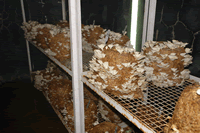 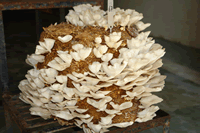 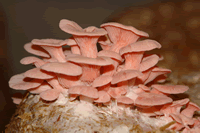 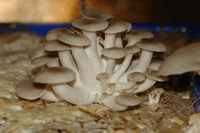
|
|
|
|
Oyster mushroom (Pleurotus spp.)
The Pleurotus mushroom is generally referred to as `Oyster Mushroom' or `Dhingri' in India. It is a basidiomycete and belongs
to the Genus `Pleurotus'. The fruit bodies of this mushroom are distinctly shell, fan or spatula shaped with different shades of white, cream, grey, yellow, pink or light brown depending upon the
species. The oyster mushroom is one of the most suitable fungal organism for producing protein rich food from various agrowastes without composting.
|
|
|
|
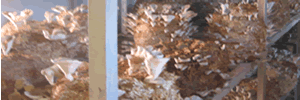 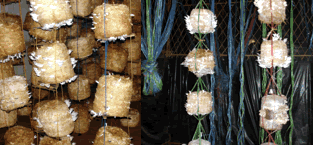  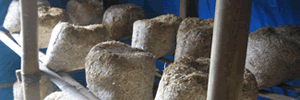
|
|
|
|
Substrate preparation
The popular methods of substrate preparation are as follows.
|
|
|
|
 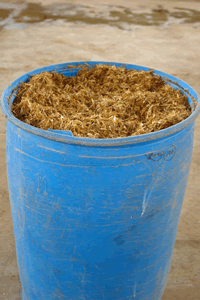  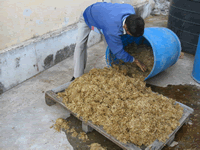 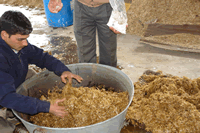 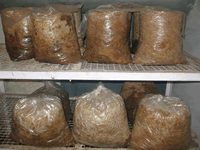 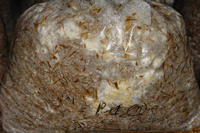
|
|
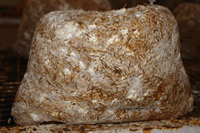 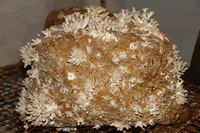   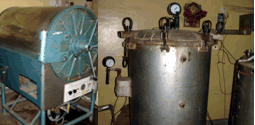 
|
|
1) Steam pasteurization:
In this method pre-wetted straw is packed in wooden trays or boxes and then kept in a pasteurization room at 60-80C for
few hours. Temperature of the pasteurization room is manipulated with the help of steam through a boiler. Substrate after cooling at room temperature is seeded with spawn. The entire process take 3-5
days.
2) Hot water treatment:
The substrate after chopping (5-10 cm) is soaked in hot water (65 to 70°C) for one hour or 60 to 120 minutes at 80C or
in case of paddy straw at 85C for 30-45 minutes. After draining excess water spawn is added. The leached water contains a lot of soluble sugars and phenolic compounds. Hot water treatment makes the
hard substrate like maize cobs, stems etc. soft so the growth of mycelial takes place very easily. This method is not suitable on large scale commercial cultivation.
|
|
|
|
Spawning
Freshly prepared (20-30 days old) grain spawn is best for spawning. Old spawn (3-6 months) stored at room temperature
(20-30C) forms very thick mat like structures due to mycelium aggregation and sometimes young pinheads and fruitbodies start developing in the spawn bottle itself. The spawning should be done in a
pre-fumigated room (48 h with 2% formaldehyde). The spawn should be mixed @ 2 to 3% of the wet wt. of the substrate. One bottle of spawn of 300 g is sufficient for 10-12 kg of wet substrate or 2.8 to
3 kg of dry substrate wt. Spawn can be mixed thoroughly or mixed in layers. Spawned substrates can be filled in polythene bags (60 x 45 cm) of 125-150 gauze thickness. Ten to 15 small holes (0.5-1.0
cm dia) should be made on all sides especially two to four holes in the bottom to leach out excess water. Perforated bags give higher and early crop (4-6 days) than non-perforated bags because of
accumulation of high CO2 which inhibits fruiting. One can use empty fruit packing cartons or wooden boxes for filling substrate. Polythene sheets of 200-300 gauze thickness of 1.25 x 1.25 m are
spread in rectangular wooden or metal box. Spawned substrate is filled and the polythene sheet is folded from all the four sides to make a compact rectangular box. It is tightly pressed and tied with
a nylon rope. The block is incubated as such and after mycelium growth polythene sheet is removed.
|
|
|
|
Cropping
The spawned bags or blocks are kept in incubation room for mycelial growth. Spawn bags can be kept on a raised platform or shelves or
can be hanged in cropping room for mycelial colonization of the substrate. During mycelial growth the bags are not to be opened or no ventilation is needed. Moreover, there is no need for any high
relative humidity, so no water should be sprayed.
Once the mycelium has fully colonized the substrate and forms thick mycelial mat it is ready for fruiting. Contaminated
bags with mould may be discarded while bags with patchy mycelial growth may be left for few more days to complete the mycelial growth. There is no need for casing the substrate. All the bundles,
cubes or blocks are arranged on wooden platforms or shelves with a minimum distance of 15-20 cm between each bag in the tier.
|
|
|
|
|
|
Harvesting
Mushrooms should always be harvested before spraying water. The right stage for picking can be judged by the shape and
size of fruitbody. In young mushrooms the edge of the cap is thick and cap margin is enrolled while the cap of mature mushroom become flat and inward curling starts. After harvesting lower portion of
the stalk with adhering debris should be cut using a knife. Stipe is kept short or almost non existent because it is hard and not liked by many consumer. Fresh mushrooms should be packed in
perforated polythene bags for marketing. They can also be sun dried by spreading thinly on a cotton cloth in bright sunlight or diffused light. The dried produce with 2-4% moisture can be stored for
3 to 4 months after sealing properly.
Medicinal and nutritional value of oyster mushroom:
Oyster mushrooms are 100% vegetarian and the nutritive value of oyster mushroom is as good as other edible mushrooms
like white button mushroom, shiitake, or paddy straw mushroom. They are rich in vitamin - C and B complex. Protein content varies between 1.6 to 2.5%. It has most of the mineral salts required by the
human body such as potassium, sodium, phosphorus, iron and calcium. The niacin content is about ten times higher than any other vegetables. A polycyclic aromatic compound pleurotin has been isolated
from P.griseus which possess antibiotic properties.
|
|
|
- Concept by : Director, DMR
- Contents : Dr. B. Vijay, Principal Scientist
- (c) Copyright. All rights reserved. DMR, Solan, HP Designed by Deepak Sharma, AKMU
|
|
|